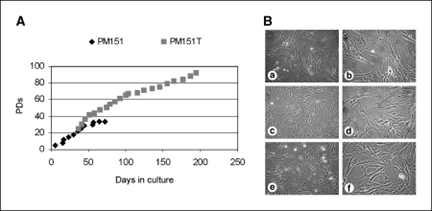Parental Line: PM151 cells derived from a radical prostatectomy specimen of a 62-year-old patient. Pathologic tumor stage was also pT3a, Gleason score 5 (3 + 2). The specimen had a positive margin, meaning that the tumor extended the prostate capsule. Seminal vesicles were tumor-free. Tissue samples used for the establishment of the cultures were removed by the pathologist from a transition zone site that was free of tumor.
Relevance: The cells provide an authentic prostate microenvironment. They may serve as a suitable experimental platform to study the transformation of prostate cells and the stem cell origins of prostate cancer. Furthermore, they could be used as a model for prostate differentiation and cell-cell interactions.
Relevant disease: Prostate cancer
Parental Line: Primary human prostate fibroblasts (PFs) (designated PF179; 179, patient number) were isolated from a prostatectomy specimen, marginal to the prostate tumor.
Host: human
Tissue: Prostate
Production details: Primary human prostate epithelial (hPEC) cultures were infected with a recombinant retrovirus encoding hTERT. Details can be found in the publication.
References
Kogan I, Goldfinger N, Milyavsky M, et al. hTERT-Immortalized Prostate Epithelial and Stromal-Derived Cells: an Authentic In vitro Model for Differentiation and Carcinogenesis. Cancer Res. 2006;66(7):3531-3540. doi:10.1158/0008-5472.CAN-05-2183

hTERT introduction induces immortalization of prostate stromal cultures. A, proliferation curves of prostate stromal cells infected with hTERT (PM151T) and their noninfected counterparts (PM151). B, morphology of prostate stromal primary and immortalized cultures: a and b, primary cells at passage 5; c and d, hTERT-immortalized cells (PM151T) at passage 37; e and f, hTERT-immortalized cells (PM151T) at passage 103 (b, d, and f are higher magnifications of a, c, and e, respectively).



